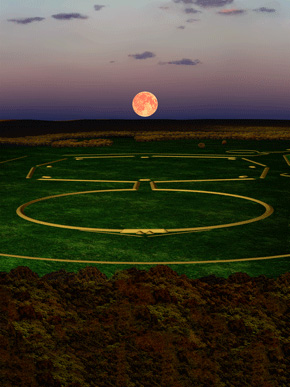NEWARK
A LUNAR CALENDAR
The lunar alignments at Newark were just discovered a couple of decades ago. Two professors from Earlham College went looking
for solar alignments at the Octagon, and initially with skepticism. Ray Hively is an astronomer, and Bob Horn is a philosopher:
So we surveyed the major symmetry axes, we surveyed the lines along the earthen walls, the lines between vertices and mounds,
and I thought, well, we’ll get a bunch of alignments to the solstice points from this. And the first shocking fact was that,
in spite of some claims to the contrary, there were NO solar alignments at Newark. And that’s when I was shocked to find
that the major symmetry axes of the circle-octagon combination, as well as 4 of the 8 walls, all align very precisely
with extreme rise and set points of the moon, which illustrated very nicely the 18.6 year cycle in the motion of those
extreme rise and set points.
Dr. Hively reflects on the significance of the fact that people living here so long ago could create such huge monuments
with such precise links to the movements of the heavens:
I think that the accomplishment at Newark is great for a number of reasons. Of course, the physical scale and precision
of it is a great accomplishment, but the fact that this structure simultaneously encodes geometrical and astronomical
information is an astounding and highly motivating discovery for any society that makes it.
Even today, modern physicists are motivated in a sense by the same kind of dual desire: that is, the desire, the passion,
in fact, to find a correspondence between mathematical symmetry and natural phenomena. That is a very powerful discovery,
and I think that we’re dealing with something like that here.
The precise geometry of Newark’s circle-octagon centers on its axial center line, beginning at the center of the
Observatory Mound and pointing 38 degrees north of east. It’s a long line of sight which, if the site were cleared
of trees, would lead the eye to a precise point on distant horizon. From here, as a result of generations of careful
measurements and designing, the ancients could predict, and bear witness to, the return of the moon to its northernmost
position – just once in every generation.
The movements of the moon are complex. Nowadays, we notice that the moon has different phases over about 29 days.
But the builders of the earthworks noticed much more complicated lunar patterns: first, about every four weeks its
rising point swings back and forth between the southeast and the northeast; and second, the width of this angle expands
very slowly over about 9 1/3 years, and then contracts again at the same rate. The moon’s setting points move the
same way across the western horizon.
So there are eight points where the moon appears to reverse direction along the horizon during this long, complex
cycle. Remarkably, all eight are marked precisely by these earthen walls and gateways. The architecture here tells
us which one mattered the most: the extreme northernmost moonrise perfectly aligns along the central axis of the Octagon.
This happened only once in 18.6 years. It must have been their grandest and most sacred festival.

Reconstruction of the axial moonrise experience, every 18.6 years, and seen from above the Observatory Mound.


